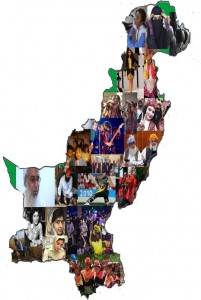Week 12: Persepolis and Pakistan
Medium: Digital Media
Explanation:
This digital media piece is inspired by both the story Persepolis and by the current situation in Pakistan discussed in class during Week 12. In Persepolis, particularly in Chapter 1, we see that the narrator, Marjane Satrapi, cannot understand the religious importance of the veil. She is religious, and grew up with religion, but she comes from a “modern and avant-garde” family. She and her family drink, engage in dances, play cards, and indulge in Western consumerism, yet they consider themselves Muslims and religious. After the Iranian “Islamic Revolution” in 1979 however, we see just how a monolithic interpretation of Islam was imposed on the people of Iran through Satrapi’s eyes. Any difference in opinion or practice was systematically eliminated, with different interpretations of Islam viewed as the “other” and thus reviled because of what was viewed as “Western contamination”.
After watching the movie in lecture highlighting Salman Ahmad’s journey to Northern Pakistan and the increasing religiously oriented enmity that his music experienced despite Pakistan’s long and rich musical history, I felt as if Satrapi’s experience is becoming increasingly relatable to many Pakistanis, despite different social and cultural contexts. Many in Pakistan are being increasingly influenced by the Wahhabi tradition, which in my opinion imposes a monolithic interpretation of Islam on its people. I believe this will not work in Pakistan because of the multiplicity of people and traditions within Pakistan itself.
This work attempts to draw on the multiplicity of traditions and people in Pakistan. I will not go into detail on the specific pictures, as the purpose of this image was to give a cursory understanding of the people of Pakistan by visual inspection; however, I will point certain things out.
We see women both covered and non-covered praying. We see Christians as well as Muslims praying. We see people with different occupations, from businessmen to street vendors to farmers, contributing to society. We see sport stars, fashion models, rock stars, and people at Western parties. We see Punjabis, Pashtuns, and Sindhis engaging in traditional cultural dance and music. We see modern looking women and we see more traditional looking women performing modern occupations. And we see members of the ulamah, attempting to engage with “modern” youth as well as members who are berating the youth for engaging in Western practices. Overall, we see a diverse Pakistan, like the Iran that Satrapi experienced before the Iranian Revolution that would be grievously harmed if a monolithic interpretation of Islam was imposed on it.
